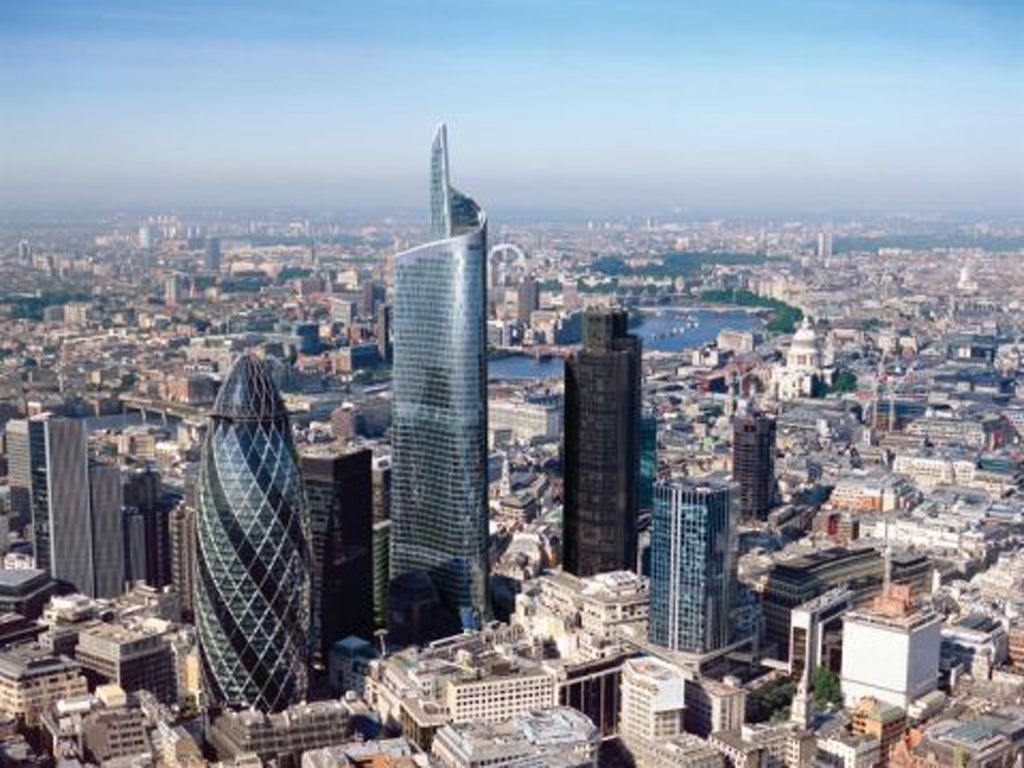Arrested development: Super-tower cut down to size
Funding worries and lack of tenants force developer to halt work on 63-storey, £800m office block

Construction of the City of London's tallest skyscraper has been stopped at just the seventh floor amid funding concerns, with serious doubts that the 63-storey office block will ever be finished.
A failure to sign up any major tenants has left the £800m Bishopsgate Tower – commonly known as "the Pinnacle" – indefinitely stunted. Prospective occupants are said to be scared of committing to costly office rental deals while the eurozone is in the grip of financial crisis.
Located at the heart of London's financial district, the Pinnacle is one of Britain's key architectural projects. Its intended height of 288m would make it Europe's second-tallest skyscraper after the Shard, which has almost been completed on the other side of the River Thames at London Bridge.
Yet with its main investor calling builders off the site two weeks ago, the ugly concrete stump left behind is a worrying sign for developers of other towers in the capital. The Pinnacle, the Shard, the "Cheesegrater" at 122 Leadenhall Street, the "Walkie Talkie" at 20 Fenchurch Street and the Bishopsgate Tower – all at varying degrees of completion – have reportedly signed only one office rental deal between them.
The news comes at an alarming time for commercial property developers across the world. A lack of clients for the 80-storey Three World Trade Centre – one of the skyscrapers replacing the twin towers at Ground Zero in New York – means it may instead have to become a mere seven-storey shopping centre.
A fortnight ago, a report by Barclays Capital warned of an "unhealthy correlation" between the skyscrapers being built and recessions following swiftly afterwards. However, Jack Sidders, of Construction News magazine, said the Pinnacle had encountered particular problems because of its innovative design. Featuring what the construction firm Brookfield describes as a "distinctive snakeskin façade spiralling to the top", it was initially nicknamed the "Helter Skelter".
"Most big corporations these days are looking for very large, open-plan spaces with flexible working space, and the tapered design of the Pinnacle is making that more difficult," said Mr Sidders. "At the moment I think it's anyone's guess what will happen with the Pinnacle."
A spokesman for the developer, Arab Investments, confirmed yesterday that work on the site had halted but refused to comment on what negotiations were taking place.
The ambitious building experienced a troubled conception. Work was delayed in 2010 while Arab Investments put together a deal involving a £500m debt facility from a collection of banks and private consortia. By the time it resumed last September, the completion date had slipped back to 2015.
The prospect of a large building site left dormant will no doubt concern the City of London Corporation, but a spokesman declined to comment on whether the authority would offer help to recruit tenants for the Pinnacle.
Meanwhile, London's other skyscrapers will continue to search for tenants. "There is widespread market sentiment that anybody building a big skyscraper at the moment is doing so in a pretty tough market," said Mr Sidders. "It would not be too surprising if other schemes were to encounter similar hurdles."
He added that the developers of the Cheesegrater and the Walkie Talkie had chosen different strategies to fill their buildings, which offered hope that they should be finished without any repeats of the stoppage at the Pinnacle.
What goes up often comes down to the weather
Rob Hastings' view from the top
For builders working on any skyscraper, abrupt stoppages to their incredibly complex operations are frustrating. Last year I went behind the scenes at the Shard – or rather above them – by visiting the cabin of the crane which dictated much of the construction work from 259m above the streets of London.
As I talked to some of the steel erectors and window cladders, it quickly became apparent how intertwined are the various parts of such a complex project. Each relies on teams from many other companies – and other countries – to keep their work on schedule.
Even without money worries in the equation, the weather is often enough to halt the work. High winds force cranes to shut down for hours, preventing materials and machinery from reaching any level of the building. For this reason, when conditions are right, construction continues at all hours, according to plans drawn up by a project manager.
London's skyscraper building boom means several of the new generation of towers have been under construction at once recently, with architects and developers criticised for simply prioritising height above all other design attributes. But in doing so, their ambitions have certainly helped the construction industry.
Work on the Pinnacle was temporarily halted at a relatively early stage, having only reached the seventh floor before builders were called off. That means the hiatus came before many of the contractors needed to turn a concrete core into a steel skeleton and then a fully fleshed-out building had arrived on site.
Nevertheless, such a pause will affect many different workers – from the concrete suppliers and lorry drivers bringing materials to the site, to crane drivers and their loading assistants below.
Subscribe to Independent Premium to bookmark this article
Want to bookmark your favourite articles and stories to read or reference later? Start your Independent Premium subscription today.

Join our commenting forum
Join thought-provoking conversations, follow other Independent readers and see their replies